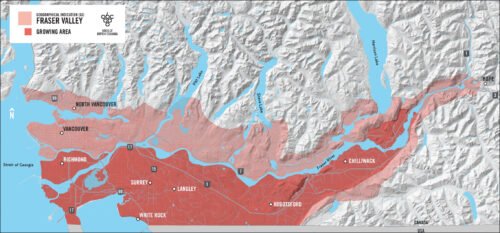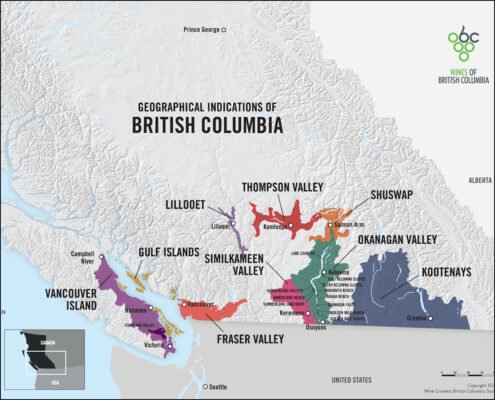The Vancouver Island wine region is located west of Vancouver, British Columbia, Canada, accessible by ferry, seaplane, or helicopter. The Strait of Georgia separates from the mainland. It is the largest island on the west coast of North America and Canada, stretching along the coastline for approximately 460 kilometres.
The island is characterized by its temperate climate, influenced by the Pacific Ocean, which results in mild winters and relatively cool summers compared to mainland British Columbia. This climate and fertile soils support the thriving vineyards and wineries, particularly in regions like the Cowichan Valley and the Saanich Peninsula.
It was officially recognized as a designated wine region in 1996, acknowledging the island’s unique terroir and establishing its wine industry within the state’s thriving wine scene. The region is known for producing various wines, including cool-climate varietals like Pinot Noir, Pinot Gris, and Chardonnay. The island’s maritime climate contributes to the unique flavour profiles of its wines. Some wineries on the island also experiment with other grape varieties suited to the climate, such as Ortega and Marechal Foch.
Many vineyards on Vancouver Island are situated near sea level or at only slightly higher elevations due to the island’s coastal geography. In the Cowichan Valley vineyards are typically located in valleys and coastal areas where the nearby ocean moderates temperatures. As a result, some vineyards may be just a few meters above sea level. The highest vineyard on Vancouver Island is located at Averill Creek Vineyard. It sits at an elevation of approximately 200 meters above sea level. While this may not be as high as some vineyards in other wine regions, it’s notable for Vancouver Island. Despite its modest elevation, Averill Creek Vineyard benefits from the unique microclimate of the Cowichan Valley, creating elegant wines.
In addition to its burgeoning wine industry, Vancouver Island boasts a rich cultural scene, outdoor recreational opportunities such as hiking, kayaking, and whale watching, and a strong focus on sustainability and environmental conservation. Major attractions on the island include Victoria, the capital city of British Columbia, and Nanaimo, known for its bustling harbour and ferry terminal connecting the island to the mainland. Vancouver Island offers a unique blend of natural beauty, cultural attractions, and culinary experiences, making it a popular destination for both tourists and residents.
Top Stats
Harvest
Mid Aug to Early Oct
Mean Jul temperature
15-20°C
Vine Area
321 acres
Altitude
0-200m
Number of wineries
22
Source Wines of British Columbia




